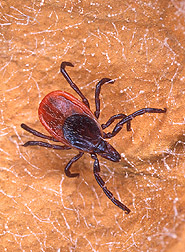This page has been archived and is being provided for reference purposes only. The page is no longer being updated, and therefore, links on the page may be invalid.
|
Read: a full report of the project. |
Tick Control Device is Tested in USDA Project to Reduce Lyme DiseaseBy Linda McGrawMay 7, 2001 A patented device developed by Agricultural Research Service scientists in Kerrville, Texas, is the basis for a five-year study to control ticks on white-tailed deer in the Northeast. Blacklegged ticks, Ixodes scapularis, transmit the bacterial agent that causes human Lyme disease, Borrelia burgdorferi. The device has a “homey” name--the “four-poster.” It consists of a bin filled with whole-kernel corn. On the four corners of the bin are paint rollers loaded with amitraz, an acaricide approved for livestock. As a deer feeds on the corn in the center, the animal rubs its head and neck against the amitraz-laden rollers. This invention offers a tick- control alternative to spraying insecticides into the environment or to reducing deer populations, according to ARS entomologist J. Mathews Pound in Kerrville. Lyme disease occurs mainly in suburban areas with an overabundance of deer. That’s why the U.S. Department of Agriculture implemented a 5-year project in the Northeast to reduce ticks on deer. The test sites include residential areas where the incidence of Lyme disease was among the highest in the country when the project started in 1997: Old Lyme, Conn.; Bedford, N.Y.; Colts Neck, N.J.; and Narragansett, R.I. The last test location is at ARS’ Henry A. Wallace Beltsville Agricultural Research Center (BARC) in Maryland. In the Northeast, where blacklegged ticks have a two-year life cycle, the researchers are targeting nymphs, the stage after larvae. In the second year, nymphs turn into adults and the females begin seeking a host--white tailed deer--that offers a large blood meal. Infected nymphs transmit the most cases of Lyme disease. Each year, more than 10,000 human cases of Lyme disease are reported in the United States, according to the Centers for Disease Control and Prevention in Atlanta, Ga. USDA holds a patent on the four-poster device. ARS is the chief scientific research agency in USDA. A full report of the project can be found in the May issue of Agricultural Research. Scientific contact: J. Mathews Pound, ARS U.S. Livestock Insects Research Laboratory, Kerrville, Texas, phone (830) 792-0342, fax (830) 792-0337, jmpound@ktc.com. |

